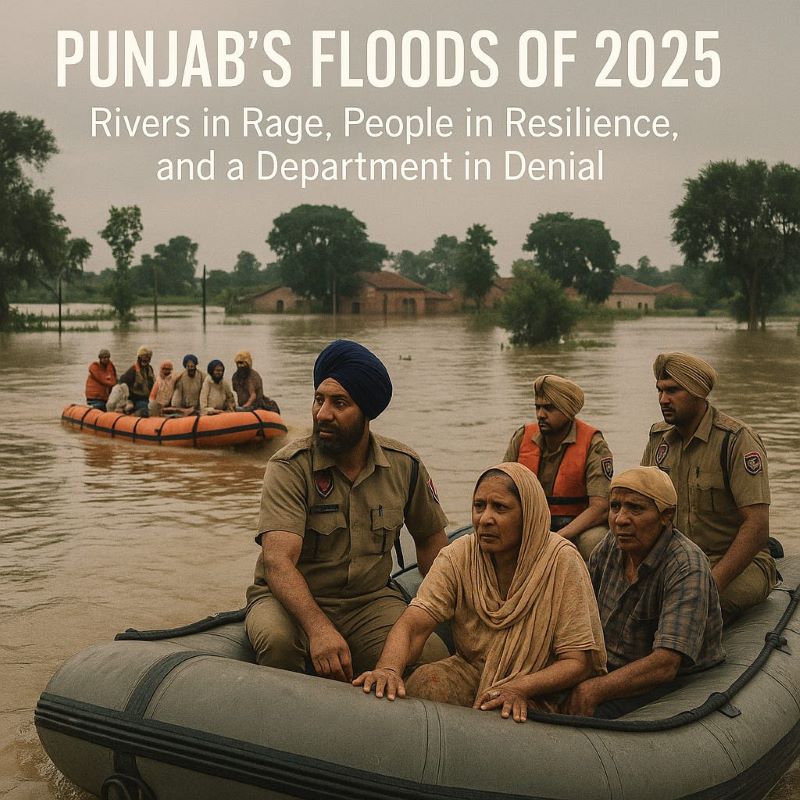 Floods in Punjab are no longer simply a natural calamity brought on by heavy rains. Over the years, repeated episodes of devastation have revealed that these disasters are increasingly manmade. Poor planning, neglect of river management, weak infrastructure, and administrative failures have all contributed to the situation, turning seasonal rainfall into widespread destruction.
Floods in Punjab are no longer simply a natural calamity brought on by heavy rains. Over the years, repeated episodes of devastation have revealed that these disasters are increasingly manmade. Poor planning, neglect of river management, weak infrastructure, and administrative failures have all contributed to the situation, turning seasonal rainfall into widespread destruction.
One of the primary causes behind Punjab’s recurring floods is the lack of proper maintenance of canals, embankments, and drainage systems. The state has an extensive irrigation network, but siltation, encroachments, and poor upkeep have choked the natural flow of water. When heavy rains occur, waterlogging and breaches become inevitable. Instead of strengthening the drainage and desilting rivers before the monsoon, successive governments have treated floods as seasonal emergencies, relying on ad-hoc measures rather than long-term planning.
The role of dams and barrages also cannot be overlooked. Mismanagement in the release of water from Bhakra, Pong, and Ranjit Sagar dams often leads to sudden surges downstream. Authorities frequently release water without proper warnings to villagers, resulting in manmade floods that damage crops, homes, and lives. If dam water were released gradually and systematically, much of this devastation could be avoided.
Unplanned urbanization has worsened the situation further. Natural floodplains, wetlands, and low-lying areas that once acted as water cushions have been encroached upon for housing, industries, and roads. Cities like Ludhiana, Jalandhar, and Amritsar have seen rapid expansion with little regard for environmental balance. As a result, rainwater has fewer outlets, causing artificial flooding even in areas that were once safe.
Another critical factor is the absence of accountability and the failure to implement flood-prevention laws. Although India enacted the Dam Safety Act in 2021, aimed at ensuring the safe operation of reservoirs and reducing flood risks, enforcement remains weak in Punjab. Departments work in isolation, passing the blame when disaster strikes, rather than coordinating to prevent it. In this sense, floods are not acts of God but acts of human negligence.
Agriculture practices have also played a role in intensifying Punjab’s vulnerability. The state’s obsession with paddy cultivation, which requires extensive irrigation and alters natural drainage, has made fields prone to waterlogging. Deforestation along riverbanks has further reduced the land’s capacity to absorb excess water. Instead of working with nature, Punjab’s development model has consistently worked against it.
The cumulative effect of these human-made factors is visible every monsoon. Villages are submerged, farmers lose their standing crops, and thousands of families are displaced. The same story repeats every few years, showing that lessons from past floods have not been learned. The tragedy is that while nature provides rain, it is human negligence, corruption, and poor planning that convert it into disaster.
If Punjab is to overcome this cycle, urgent corrective steps are required. The Dam Safety Act must be strictly enforced, with reservoirs undergoing regular safety audits and water release protocols made more transparent. Rivers and canals need systematic desilting, while encroachments on natural drainage channels should be removed and wetlands restored. Cities should adopt flood-resilient urban planning and halt construction in floodplains, while modernizing storm water drainage systems. Agriculture too needs a shift, with farmers encouraged to diversify away from water-intensive paddy and embrace crops that are sustainable in Punjab’s ecology.
Equally important is the creation of an integrated flood management authority to coordinate between irrigation, agriculture, environment, and urban development departments. The use of satellite monitoring, flood forecasting systems, and GIS mapping can help in predicting risks and responding quickly. But reforms will remain incomplete unless accountability is enforced. Officials who mismanage dams or neglect river maintenance must be held responsible so that negligence is not repeated year after year.
Punjab’s floods are not a curse of nature but the result of decades of human-made negligence. With strong political will, scientific management of rivers and dams, and strict enforcement of laws, these disasters can be prevented. The people of Punjab deserve not yearly relief packages but permanent solutions. Unless immediate reforms are undertaken, floods will continue to haunt the state as a tragedy entirely of its own making.
Share via: